.
A Day in the Life of a 9/11 Photographer
By Ed Zier
There was no warning. No way to prepare herself for the carnage she was about to witness. Yet, as an accomplished photojournalist, Brigitte Stelzer would soon insert herself right smack in the middle of one of the worst days in American history. She would run against the grain of fleeing office workers to capture grave images of unspeakable horror, and join first responders as a willing participant in the tragedy of 9/11. However, none of that eventual reality was apparent to Brigitte at 7am on the infamous morning. In fact, it was supposed to be her day off.

Brigitte Stelzer [Photo Credit: Martin Schalk]
Breaking News Photography
Brigitte labels herself a Breaking News Photographer. In that role, she is always “on call,” ready to go anywhere in the five boroughs of New York City or across the country to capture real life drama on a moment’s notice. She loves her job, but admits it can be emotionally draining. “There’s a lot of pain in these stories, because if you do breaking news, you do homicides, you do fires, you do all these victims. You do suspects in court.” While the events can be horrific and devastatingly sad, Brigitte finds solace and pride in bringing comfort to people. For example, Brigitte shared a story of a mother who had just lost a child. “You’re doing a story about a victim in front of you and it’s a mother who just lost her five-year-old. And before you start taking photos you try to get to know her and gain her trust for a couple minutes. She (ends up) hugging you because she’s in so much pain. I’m proud that I’m there for that moment that I can give that person. Even, if it only helps for that minute, that’s priceless.”
In the jungle that is news photography, Brigitte is also proud of the facial expressions, emotional reactions, and events she captures. “The picture you capture at that moment speaks to the world. It explains the entire story.” While covering a famous courtroom verdict, Brigitte said of the not-guilty decision: “just the expression of his face – you knew everything.” She added, “That is what I love to do. You know, a picture does not lie. That’s the story right there. You take the photo and it’s out there, and people can see it, and that’s (a job) well done.” Her experience and pride with comforting victims and capturing history with a click of the camera’s lens served her well on 9/11.
The Day Takes a Surprising Turn
After capturing candidate Green in action, Brigitte was ready to begin her day off. A day without further distractions. A day where she and her (now) husband, Jerry, could spend some quality time together. But the job of a breaking news photographer is never done. The newspaper additionally requested that she handle one more, small task. Apparently, teachers were demonstrating outside a school on Manhattan’s east side. Brigitte was soon there, but after taking several pictures a much larger story was developing. A world-changing story – right in Brigitte’s city.
While standing on the sidewalk adjacent to the school, Brigitte found herself in proximity to two police officers who were engaged in a very serious conversation about the World Trade Center. It was about 8:50am. Brigitte overheard one say, “oh, that’s probably just a little Cessna that flew into the towers.”
What? She thought to herself. What did he say?
Being a breaking news photographer, Brigitte owned a police scanner and quickly tuned in. She confirmed an airplane had indeed flown into the World Trade Center, and then heard the dreaded words of “code red.” According to Brigitte, “once you hear Code Red – it’s catastrophic.” Her mind was no longer focused on her day off, and she instantly called her photo editor. She barely got to say hello, when the Post’s photo editor said “Brigitte, go!” She jumped in her car and headed south.
At this point, Brigitte’s adrenaline was in overdrive. Her experiences and love of photography ran deep. Ever since the age of fifteen in her hometown of Vienna, Austria, Brigitte had been enamored with capturing head-turning images. “(Back then) I found a camera and started taking pictures left and right of anything and everything. I found that the beauty of getting that millisecond chance to capture something just grabbed me.”
As her car sped south on the FDR Drive in Manhattan heading for the Twin Towers, Brigitte learned that the second tower had also been struck. She could see the large dark plume of smoke from the highway. She also knew that this was no lone Cessna, and was indeed catastrophic. She was able to get as far as the Fulton Fish Market on the East River, and decided to park there. All other avenues were sealed off.
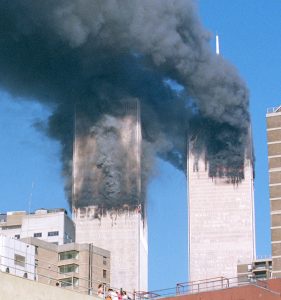
The first photograph of the Twin Towers taken by Brigitte on 9/11 soon after she left her car at the Fulton Fish Market. The south tower is on the left. [Photo Credit: Brigitte Stelzer]
Arriving at Ground Zero
When Brigitte arrived on the scene she found herself at the corner of Church and Fulton Streets, right in front of the Millennium Hotel, which sits directly across from the sixteen-acre World Trade Center site. The south tower, also known as Two World Trade, loomed directly above her. It had been the second building impacted, but would later be the first to fall.
Her senses immediately detected a rancid environment. “There was a really bad gasoline smell, and a bad, bad burning smell everywhere. It was horrible. There was basically no clean air around us. It was just horrible. And there was a lot of debris already, like fine concrete dust sort of like from the walls that were impacted by the planes. It wasn’t good. And it was really hot. But you don’t feel it as you take pictures for breaking news. You just go for it. It isn’t anything that bothers you at the moment. You just think about it afterwards.”
When asked if she was scared upon arriving at the scene, she replied, “I was shocked. But I wasn’t worried, because nobody at that minute knew that the tower would ever come down. What did worry me was the horrible fires and how they were going to bring those people down.” In fact, Brigitte recounts that her first pictures on site were those of people waving white towels or handkerchiefs high in the towers, clearly desperate for assistance. It wasn’t hard to understand their collective plight. In the north tower (One World Trade), American Airlines flight 11 severed all three stairwells trapping everyone who was above the 93rd floor. In the south tower (Two World Trade), United Airlines flight 175 destroyed two of the three stairwells above the 78th floor, and greatly limited access to the third. However, that last remaining staircase did provide an escape route for several fortunate individuals that morning, including twelve from a company known as Baseline which was located on the 77th and 78th floors. Unbeknownst to Brigitte, two of those workers would descend by staircase and soon factor into a famous photograph of hers.
In an aggressive attempt to take better photographs of the people seeking help far above street level, Brigitte tried to enter the Millennium Hotel. Twice. Her aim was to reach the roof of the hotel. She was immediately repelled by hotel security despite her desire to better capture the events of the day. Within a few minutes, she attempted a bathroom visit hoping to circuitously avoid detection. That endeavor was also rebuffed. She apologized to hotel staff and exited to the street.
Brigitte immediately turned her attention to the injured. A triage center had been established right in front of the hotel. Police and EMT workers were carrying or escorting those seriously wounded from the Trade Center’s exits to await paramedic care on the sidewalk in front of the hotel. Those grievously injured would be ushered away in ambulances to local hospitals.
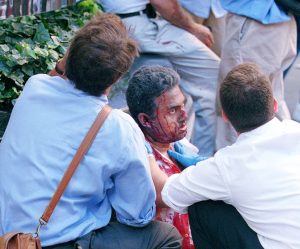
A man struck by a metal fragment of an airplane, which is lodged in his chest, is attended to by paramedics. [Photo Credit: Brigitte Stelzer]
Encountering Baseline Associates
When Brigitte realized that the injured were coming from the tower exits, she positioned herself directly beneath the south tower. Immediately, she spotted a pregnant woman by the name of Jyoti Dave Vyas (a systems analyst with Baseline) exiting the tower. She had just descended 77 floors of stairs with her fellow employees. Jyoti was exhausted, and was being helped by her colleague Simon Chen and an NYPD officer by the name of Ramon Suarez. They carried her across Church Street to the makeshift triage center where she was deemed in need of immediate hospital care to inspect the condition of her in-utero child. She was quickly whisked away in an ambulance. The good news is that Jyoti gave birth two months later to a very healthy daughter, Shailaja. In Hindi, her name means “Daughter of the Mountain” and according to Jyoti “that seems fitting as she descended from the mountain called the World Trade Center.” Brigitte’s famous photograph is also showcased in the book Undaunted: Leadership Amid Growth & Adversity, which highlights the plight of Baseline’s employees during and after the tragic events of 9/11.

Dave Vyas, seven months pregnant, is seen here immediately after concluding a 77-floor descent. A colleague, Simon Chen, and heroic NYPD officer Ramon Suarez, who died in the line of duty that day, lend assistance. [Photo Credit: Brigitte Stelzer]
Most tragically, Officer Suarez laid down his life that day by saving others. According to Brigitte, the south tower fell only five minutes after Officer Suarez re-entered the building to locate others in need of help. Brigitte spoke with emotion when she said, “that’s heroism at its max! You can’t even find the right words to describe his actions. And, that is what I’m proud of… that I could find that moment to capture this cop’s strong belief in ‘whatever it takes’ to save people.”
An Unexpected Horror
At 9:59am on the infamous morning, while Officer Suarez was still inside the south tower, Brigitte was prompted to look skyward. She recounted the moment: “I’ll never forget that terrible noise. The first thing I heard was a noise, and that’s why I looked up. It was a deep, growling concrete-breaking noise. Oh my God, it was so loud! The top of the tower just came out sideways with the cloud. All of a sudden the top falls from the side and comes toward me.”

This photo was taken by Brigitte Stelzer at the moment she began to hear a loud, incredible noise. The south tower had begun its collapse. [Photo Credit: Brigitte Stelzer] …………………
Brigitte continued: “Everybody around us turns and runs for their lives. The situation is like you’ve never (seen) before. If you did not have an experience like this, you wouldn’t know what I’m talking about in the sense that I had no idea how I ran so fast. I had no idea how I made it into this Chase Bank building.”
To be sure, the bank building Brigitte is speaking of was two hundred yards away – down a full block of Fulton Street and across Broadway. To her credit, while in a full sprint, Brigitte quickly took a few photographs of the toppling structure and resultant debris cloud. Brigitte recounted her ordeal: “The concrete cloud from the top of the tower travelled faster than we could run. As I crossed the first cross street (Broadway) towards the bank, that concrete (cloud) almost came into us and we heard all these concrete blocks coming down behind us. It was a huge, overwhelming noise. It was horrible!”
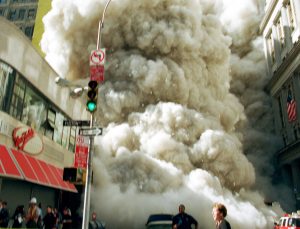
In her frantic escape from the foot of the towers, Brigitte had the wherewithal to take a picture of the debris cloud as she ran. At this very moment, Brigitte is crossing Broadway. [Photo Credit: Brigitte Stelzer]
When asked if she thought her life was in danger as she ran from the cloud, Brigitte quickly responded: “I didn’t think anything. I just ran. My brain just shut. It’s like you’re traumatized and you fight for your life. It’s like a different grade level of thinking in your mind. I really can’t explain it (better) than this. It’s just that you don’t think. You don’t have time. You just run and you’re numb, and all of a sudden you realize, Oh wow, I’m still alive. I’m good. I’m okay. What happened?”
The Emergence of Light
It took about twenty minutes for the darkness to give way to sunlight and the visible evidence of complete devastation. When Brigitte emerged from the bank building she knew the other tower was still standing, and amazingly made her way in that direction. Her goal was not evacuation, but more pictures. She seemed to overlook the obvious danger in favor of her assignment. She summed up her sentiment by saying, “For me, when I focus on my camera and my assignment, I don’t have that ‘being myself’ personality. I have that ‘you’ve got to take the best pictures you can at that moment to capture everything for everybody to see’ personality. That focused bravado propelled Brigitte towards the north tower, although as she went in that direction two FDNY firemen stopped her. They asked, “Where are you going?” She instantly quipped, “I want to go towards the other tower, the north tower!”
Their response was quick and adamant. “No, you’re not!” With her mission in mind, she made them aware of her role as a press photographer, which often resulted in access to crime scenes and other events. But, the firemen laid out the cold hard truth. They said, “Listen, we have live wires and electricity everywhere. Do not go in that direction. You’re not going to make it.” A dose of reality had her reconsider her plans. Brigitte shared that in very hectic and chaotic moments around crime scenes, her concentration is on her photos and not necessarily safety. “You have to be careful where you step and where you go for security reasons. You have to follow the (professional) advice.”
While she acknowledged the need to heed official instruction, she persisted with why her pursuit of momentous photographs is warranted. “They keep us in check, but at the same time you’ve got to get the moment of the photo. If I hadn’t taken that picture of this poor pregnant woman being brought out by this amazing and proud NYPD cop, (the policeman’s) wife would never (have) seen the last picture of her husband, and the bravery he came out of this tower with to (assist) everybody around him—but him.”
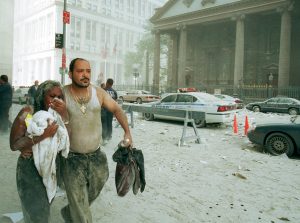
Soon after the two firemen had turned Brigitte away, she found herself on Broadway only a block from Fulton Street. St. Paul’s Chapel in the foreground, built in 1766, sustained no damage and became a centerpiece for rescue and recovery in the days and weeks ahead. [Photo Credit: Brigitte Stelzer]
When Reality Set in
At the moment the firemen thwarted her advance, Brigitte resigned herself to the fact that her fieldwork was likely over for the day. She started walking, then running, north on Broadway towards City Hall. She was an emotional mess, and knew she couldn’t drive. She recalled the moment: “I wasn’t capable of going to my car because I was in so much shock. I was shaking. I was upset. I was crying. I did everything at the same time. So I left my car at the Fulton Fish Market. I just wanted to make it to the (Post) to get my pictures developed to get them in the papers as soon as possible.” Her professional obligations never left her conscience.
At the same time, Brigitte also realized that she had no idea what had just occurred. The who, what, and why were still unknown to her. Phone service was impossible due to the sheer volume of attempted calls. Telecomm bandwidths were maxed out. Very few people on the streets had access to news reports. She added, “I had no idea if the world was attacked, if America was attacked, if New York was attacked. I had no idea what just happened. I was just traumatized. As I ran towards City Hall, the north tower came down.” Upon some reflection it dawned on Brigitte that “those two firefighters saved my life!”
That realization caused her to stop, catch her breath, and review the morning. Her mind quickly revisited her time at the Millennium hotel, where security guards had thwarted her creative ideas to reach the roof. Once again, Brigitte concluded that those gentlemen also saved her life. With information gained in the subsequent days, she confirmed that notion. “As the (south) tower came down it damaged most of the front of the hotel and the roof, and I would have been standing there on the roof of the hotel if they had let me in.”
During her walk north on Broadway, Brigitte couldn’t help but face the reality behind her. She was likely saved twice, but realized thousands had just lost their lives. She recalled that that was a lot to consider, and yet, still moved forward with her press duties.
Brigitte was probably three miles from her destination, the Post’s headquarters, where her photos would be developed and examined for possible inclusion in the next day’s paper. However, she discovered that her right foot was bothering her, and walking to the office would be difficult. She got as far as Canal Street on foot, but then luckily flagged down a jeep. According to Brigitte, the driver “was nice enough to take me, and he also took three more people off the street that were looking to run away from the towers.” The driver of the jeep took her directly to the Post’s building on 47th Street in midtown Manhattan.
Upon arrival at the Post, Brigitte discovered a sad revelation. “I went upstairs to develop the film, and when I was done I realized some of my film was gone. I only had two film rolls out of five. It was devastating for me. I have no idea where it went. It’s something I have to live with.” She admits, however, being pleased with the results she still possessed.
At the end of an exhausting, and emotionally draining day, Brigitte made it home. To her astonishment her right big toe was completely black. She knew there might have been an issue, but this showed her what adrenaline can do to keep one moving forward despite setbacks. She resumed her photographic duties two days later. She would focus her lens on rescue and recovery efforts, as well as on the heartbreaking souls who gathered at what is now known as Ground Zero to look for loved ones. That despairing work took its toll on this normally upbeat photojournalist.
Reflections
Brigitte Stelzer admits that the day changed her. On one level, she sees tall buildings differently and often finds herself on alert. She says, “Driving through Manhattan if I have my sun roof open, and I look up sometimes waiting for the intersection to change, I look up at the high-rises and my first thought is please do not come down on me! That’s what changed. Because, you never know. Listen, anything can happen again.”
On a deeper level, Brigitte acknowledges that she is still profoundly despondent about the day. She recently shared that “while my professional duties might require me to be at Ground Zero, as a private person I don’t like to go back there. I don’t like to see it. I just feel incredibly sad about all those poor souls down there. It still saddens me to this day. I like to avoid that area as much as possible.”
When asked how she felt about emotions arising from the interview for this article, and how it made her feel, she quickly responded. “Oh, I don’t mind talking about it. I just don’t want to be there.” She then added, “It’s a very delicate matter in many directions because it opens all these wounds. But, it’s also good to talk and to let it out, because that’s a part of healing.”
Thank you Brigitte…for your professional conduct, your comforting spirit, and your many photographs that help us never forget 9/11.
* * * * *
Photographs used pursuant to license from Brigitte Stelzer.
Ed Zier is the former COO of Baseline Financial Services, and the author of the book Undaunted. Published in 2021 by Koehler Books, Undaunted details the true story of Baseline’s employees on 9/11 and the weeks that followed. Mr. Zier became aware of Brigitte Stelzer by virtue of her famous photo of Ms. Vyas and Officer Suarez, which he licensed for use in his book.

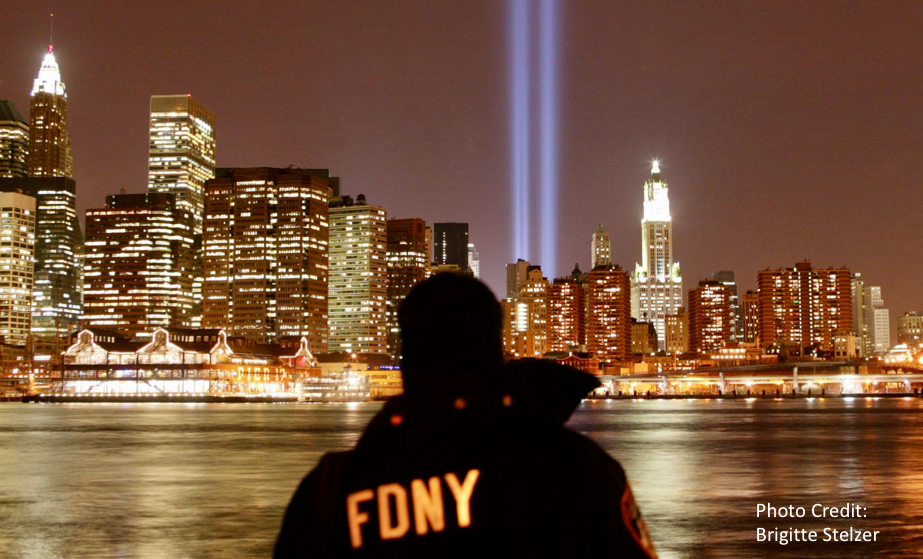

Brigitte Steltzer did not “snap” pictures. She made photographs and documented history. Photojournalists and photojournalism deserve more respectful language.
Fair enough. Well said.